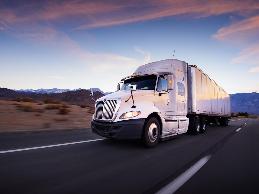The trucking industry can bring a unique set of challenges when it comes to accommodating employees with motor-related impairments. The limitations caused by these impairments can vary, but frequently reported limitations include back pain while sitting, lifting restrictions, and problems with reaching and bending. Luckily, there are more assistive technologies and equipment options becoming available to enable people with disabilities to perform their job tasks specifically in and around trucks.
When employees are limited in reaching overhead due to back impairments or shoulder injuries, they can use a step stool or aerial lift that can raise the employee up so that reaching is performed at or below shoulder height. For example, a long-haul trucker who contacted JAN often had to move trailers with open loads, such as wood, hay, pallets, and scrap metal. Periodically, the loads had to be covered with a tarp and fastened with a ratchet strap. This particular driver had problems accessing the top of his load. He was provided with a small aerial lift that attached to the trailer to complete this task.
Entering the truck may pose a problem for employees with climbing restrictions. Options to consider can include extended tractor steps and folding steps that both provide additional steps, which can reduce the climbing distance to get into the truck cab. There are also seats that swivel and sometimes extend out of the truck to make it easier for someone to enter. For example, an over the road truck driver with a hip impairment could not climb the large standard truck steps. The employer modified his truck with extended tractor steps that enabled the driver to enter the truck comfortably.
Moving and lifting materials and goods can be physically demanding, especially for someone with a motor impairment. Products that may help include winches and chain hoists, hitch systems, truck mounted cranes, compact mobile cranes, and lift gates. For instance, a package delivery driver often has to move large boxes weighing upwards of 75 pounds. A driver with a back impairment had a lifting restriction of 25 pounds. The employer purchased and installed a lift gate for this specific truck that raised the boxes from ground level into the tractor-trailer.
Sometimes truck drivers are required to do maintenance and/or visually check the underside of the truck or load. An employee may consider the use of low task chair or mechanic’s seat and creeper if limited in bending, kneeling, or stooping. In another JAN call, a tow truck driver returned to work following surgery to repair a torn meniscus. In order to strap down the car, the driver had to get on the underside of the tow ramps. He had bending restrictions in one leg, but was able to perform this task by using a low task chair.
Although it can be tricky to consider alternative ways of doing things in and around a truck, these products and others can enable a qualified truck driver with a disability to effectively and efficiently perform job tasks.
Resource:
Trucking with a Disability
Dan Woog, Monster.com Contributing Writer








